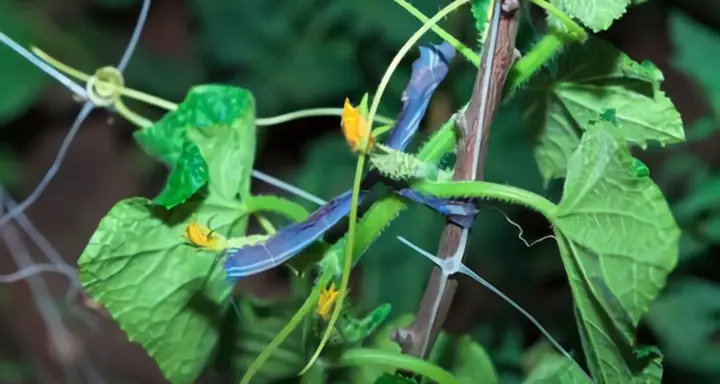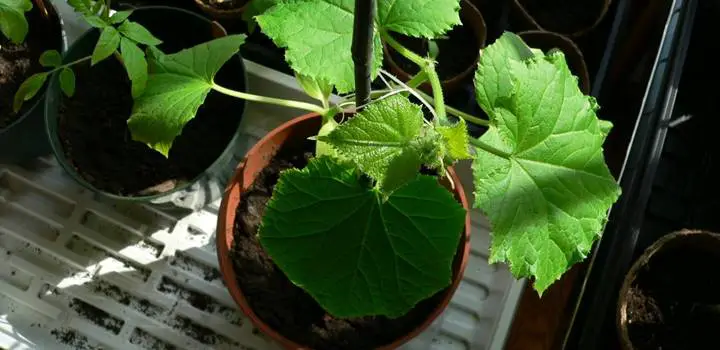Cucumber is a widely cultivated vine of the family Cucurbitaceae. Cucumber plants often suffer from white spots on the leaves.
The white spot doesn’t do any fatal damage to the plants but it deteriorates the quality and quantity of the cucumbers. So it’s very important to take action as soon as you notice them.
Powdery mildew, Cercospora leaf spot, and pest attacks are the causes of white spots on the cucumber plants.
Remember; taking the wrong action can ruin the plants. So, Before starting to treat the white spots on your cucumber leaves you must learn what is the reason behind this.
In this article, I’ve tried to explain the causes of white spots in cucumber leaves with their applicable solutions.
So, without losing your time, let’s get started-
White Spots On Cucumber Leaves-Reasons and Solutions

1. Powdery Mildew
Powdery mildew is a very common and very devastating disease of cucurbits plants, especially for cucumber and squash. It’s a fungal disease that is mainly caused by Podosphaera xanthii. It produces white spots on the leaves of the plants.
It looks like someone dusted the leaves with powder and you can remove it with your fingers. But sadly the powdery spots will return very soon.
Powdery white spots can form on both the upper and lower sides including the edges of cucumber leaves. These spots start to become larger very quickly. It can even cover the entire leaf and stem. Severe infection can make the leaves and buds twisted and distorted.
The ideal condition for Powdery Mildew is-
- Moderate temperature around 22-32°C
- High humidity
- Dry foliage in shady condition
- A high density of plants with little air circulation
When all the above conditions combine it causes white spots on cucumber leaves.
Powdery mildew mostly occurs during the late spring or early summer when evenings are cool but a little humid, while the days are starting to get warm. But It does not spread very much in rainy conditions.
It affects shady plants faster than plants that are under direct sun. They spread to other plants very easily, usually by wind, insects, water, and garden equipment.
It’s very important to treat the plant as soon as you see the white spots on the leaves because it reduces fruit quality and the amount of cucumber yield.
Control Measure
Thin out the infected leaves and dispose of them to reduce further spread. After that
You can apply Sulfur or Copper fungicides (our pick: Bonide 775 Copper Fungicide Rtu Natural) to control this fungal problem.
Homemade solutions can go a long way in controlling them. Some of the easy and effective recipes are given below-
#Milk Spray
Mix 100 ml of milk with 100 ml of water and spray it twice a week until the problem fix.
#Baking Soda Spray
Add half a tablespoon of baking soda and 1 teaspoon of oil in 2 liters of water. Spray once a week.
#Vinegar Spray
Mix 2 tablespoons of apple cider vinegar in 4 liters of water and then spray it on the infected leaves.
#Neem Oil
Mix 3 teaspoons of neem oil in half a gallon of water and spray it. You can also buy ready-to-use neem oil (our pick: Monterey Neem Oil Ready-To-Use)
Preventive Measure
Prevention is the best way to control powdery mildew. You can plant resistant varieties of cucumbers like ‘Brittania’, ‘Cobra’, ‘Excelsior’, etc.
Plant them in a sunny location with 5-6 hours of sunlight and provide proper spacing to allow air circulation. You can grow them in trellises or framed structures.
Water early in the morning so that the leaves get enough time to dry and try to avoid wetting the leaves. Add organic mulch like dry leaves, straws, wood chips, etc.
Avoid over-fertilization of Nitrogenous fertilizers. Disinfect any tools like pruning shears or spades with bleach after working with diseased plants
2. Cercospora Leaf Spot / White Leaf Spot
Cercospora Leaf Spot / White Leaf Spot is another fungal problem of cucumbers. The young leaves start to get white spots with black margins. Then the spots start to become brittle and fall out. This disease is usually seen from July to October.
Control Measure
It’s important to burn the infected residues to stop further infection. Once the infected leaves are removed you can apply fungicides that contain myclobutanil, thiophanate-methyl, copper (our pick: Spectracide Immunox Multi-Purpose Fungicide Spray Concentrate)
Also, you can apply neem oil spray or copper spray to control organically. The recipe of homemade copper spray is given below-
#Copper Spray Recipe
Add 5 teaspoons of copper sulfate and 5 tablespoons of calcium hydroxide (also known as hydrated lime) in 2 liters of water. You can spray this solution in 10 days intervals until harvesting.
Preventive Measure
You know; Prevention is the best way to combat this disease. Here are the preventive measures that can help you to get rid of the leaf spots-
Avoid overwatering. Do not water during late evenings otherwise leaves will be damp the whole night. Keep proper plant spacing and use disease-free seeds.
Remove the infected leaves because if the leaves fall on the ground they will remain there to attack in the future.
3. Pest Attack
Spider mites, Leaf miners, and Thrips usually attack cucumber plants and produce white spots on the leaves
In the case of spider mites, the spots look like white dots. It may even lead to the drying of the leaves. If you check carefully you will find small webs on the lower side of the leaf.
Another reason for white spots can be the presence of thrips. They are very tiny and they may appear as white dot-like structures on the leaves.
Leaf miners also make white spots or line-like structures on the leaves and bore their way into the leaves.
Control Measure
Take the best quality pesticide for your plant and spray according to the label directions. You can pick the all-in-one solution that can control insects and mites. (Our pick: Ortho Insect Mite & Disease 3-in-1 Ready-To-Use)
Also, you can pick Bifenazate or Permethrin, or Cypermethrin containing pesticides for mites. And Pyrethrin or Imidacloprid containing pesticides for insects.
Horticultural oil, neem oil, garlic, and onion spray or insect traps are effective against pest attacks. Here I am adding some amazing homemade solutions that you can make-
#Garlic and Onion Spray
Mince one clove of garlic and one small onion. Then add 3 teaspoons of liquid soap with them in 1 liter water and blend. Strain the mixture and put it into the sprayer
#Horticultural Oil
Mix 3 teaspoons of liquid soap with 250 ml of any oil like soybean oil or vegetable oil. Then mix 4 teaspoons of this mixture with every 250 ml of water and pour it into the sprayer.
#Insect Trap
Take a wood or plastic piece. Paint it yellow because yellow attracts insects. Apply any sticky material like engine oil or petroleum jelly on it. Then set it near your plant.
You can re-use it whenever necessary by just applying the same sticky material.
Preventive Measure
Insects prefer dry conditions so keep the soil moist, don’t let it too dry.
To get rid of white spots, collect all the infested leaves of your cucumber plant and burn them. Do not over-water and over-fertilize. You can free some beneficial insects like lacewings, ladybugs, and ground beetles in the area so that they will kill the harmful insects in your garden.
Conclusion
I have covered every possible cause and effective solution for white spots on potted or inground cucumber leaves and I hope you got the right solution.
To cut a long story short; apply good quality fungicide or insecticide and take some easy preventive measures to get rid of the white spots on your cucumber leaves. And enjoy the yummy cucumbers.
